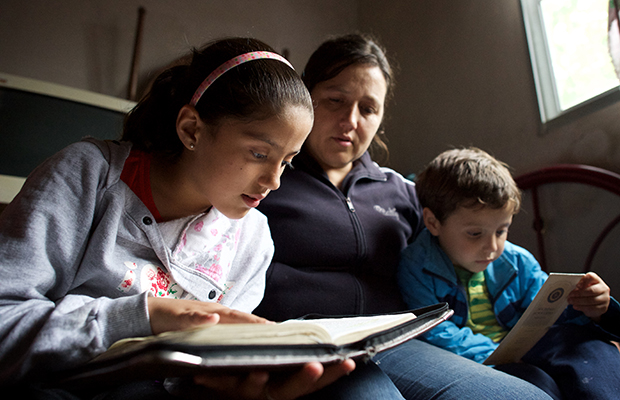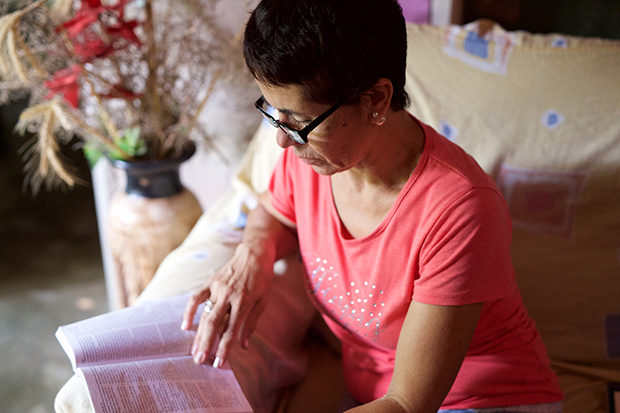Get a Sneak Peek at the New Church Curriculum for 2019
Contributed By Marianne Holman Prescott, Church News staff writer

The new curriculum is meant to be a guide to help strengthen individuals and families in their faith. Rather than just focusing on lessons to be taught in church, the new curriculum shifts the emphasis to studying as individuals and families at home.
Article Highlights
- The emphasis of the 2019 curriculum is studying as individuals and families at home.
- Teacher manuals are meant to be an additional reference to the home study.
- The new curriculum is a guide to help strengthen individuals and families in their faith.
“[Research has] found that scripture study in the home—personal religious devotion—had a greater impact on conversion than anything else.” —Brian J. Hansbrow, curriculum developer
Related Links
Not even a week after the Come, Follow Me curriculum first launched in 2013 for the youth of the Church, the late Elder Robert D. Hales of the Quorum of the Twelve Apostles asked the question, “When are we going to do this for the adults of the Church?”
Church members now have the answer to Elder Hales’s question.
“We have been working to try to figure out what we ought to do for the adults of the Church,” said Brian J. Hansbrow, a curriculum developer for the Church.
Early in July, the Church announced that a series of resources—Come, Follow Me for home, Sunday School, and Primary—will be available for classes beginning in January 2019.
A sneak peek into what Church curriculum will look like in the future was the topic of a course at BYU’s Education Week, held August 21–24. A group of Church employees who have worked on developing the new curriculum offered the presentation.
Although many of the same principles used in the current Come, Follow Me youth curriculum will be applied in the new home, Sunday School, and Primary courses, a major component to the curriculum has changed.
Rather than just focusing on lessons to be taught in church, the new curriculum shifts the emphasis to studying as individuals and families at home.
“Programs of the Church are home centered and Church sponsored,” said Mike Magelby, director of curriculum for the Church, during the Education Week presentation. “Your study starts at home. You will get the doctrine and learn things from the home manual.”
One of the main ideas for the new curriculum came from section 1.4 of Handbook 2: Administering the Church, which reads: “God has revealed a pattern of spiritual progress for individuals and families through ordinances, teaching, programs, and activities that are home centered and Church supported.”
Rather than focusing on just the teaching in the weekly Church-meeting block, much of the learning is to be done at home so that church learning becomes a support—rather than the primary source—to teaching and learning in the gospel.
“Conversion is the end goal, and we know that the Spirit leads to conversion,” said Hansbrow. “The previous curriculum model … worked under the assumption that better church experiences lead to more of the Spirit, which leads to deeper conversion. In order to have better church experiences we had to have better teachers.”

Rather than focusing on just the teaching in the weekly Church-meeting block, much of the learning is to be done at home so that church learning becomes a support—rather than the primary source—to teaching and learning in the gospel.
Curriculum writers realized there are a lot more hours in the week than the one or two hours members spend in class at church. Because of that, they felt the need for more home learning.
“[Research has] found that scripture study in the home—personal religious devotion—had a greater impact on conversion than anything else. … Interestingly, the research bore out that family religious devotion was the greatest cause of personal religious devotion. We felt that was a really important idea,” Hansbrow said.
Recognizing that Sunday School—as well as the other classes at church—is still an important opportunity for Church members to gather and worship together, curriculum writers decided they needed to elevate Sunday worship.
“And so we came up with our new curriculum model, which still has conversion as the goal, … and the Spirit is what deepens conversion,” Hansbrow said. “We’ve added personal religious behavior as the next ingredient in that equation.”
After testing the curriculum in seven countries and 35 stakes over four years, the curriculum team said that the results were powerful.

Although the new resource provides activities to do as a family, the home study is applicable for individuals who live alone or whose family members are not interested in studying with them.
“The beauty of what happened in those tests is that people … we interviewed … didn’t talk so much about the manual; they talked about the scriptures,” said Bryce A. Anderson, a product manager in the Church’s Priesthood and Family Department. “They would say, ‘Before I would tell my kids scripture stories, and now we are talking doctrine and principles. It has sort of elevated how we read and study the scriptures.’”
How will the new curriculum look?
So how will the new curriculum look?
All Church classes—Primary, youth Sunday School, and adult Sunday School—will study the same passages of scripture each week.
“Youth Sunday School will go back to studying the scriptures—[all classes] are aligned [so] they are all the same scripture block every week,” said Mike Barber, a curriculum developer. All of the classes “will be aligned with this home resource.”
In 2019, the Church will study from the New Testament. Rather than giving each adult member a class study guide at the beginning of the year, every household will be provided with a home study guide that goes over the scriptures for the week that will be discussed during Sunday classes.
Unlike the small study guides of the past with only a list of scriptures to draw from, the new guide includes activities, questions, and “helps” for individuals and families to deepen their gospel study.
Each week includes a few pages of content that contains the scripture passage, an introduction paragraph, ideas, and prompts for scripture study and activities, as well as ideas for family home evening. Additional resources, including images, are also included in the week’s study.
“We tried to make this not sound like a manual, so I think you’ll start to see that the writing is a little different than what you’ll find in a Church manual as a teacher,” said Barber.

Rather than focusing on just the teaching in the weekly Church-meeting block, much of the learning is to be done at home so that church learning becomes a support—rather than the primary source—to teaching and learning in the gospel.
Curriculum developer Paul Murphy added: “Children ages 3 to 11 will be in Come, Follow Me. Everybody is going to be in the scriptures during Primary and Sunday School.”
The new manual will be available digitally through the Gospel Library app and online at ChurchofJesusChrist.org sometime after general conference, and units should expect to get their hard copies near the end of the year.
Relief Society, priesthood, Young Men, and Young Women will continue to follow the doctrinal approach pattern that has been established.

The new approach helps everyone to study from the same materials but in many different ways, bringing different insights to the classroom.
Although the new resource provides activities to do as a family, the home study is applicable for individuals who live alone or whose family members are not interested in studying with them.
“We’ve got young single adults and individuals who are married and a part-member family and new converts and unsupported youth in the home in a lot of areas,” said Chad Strang, who is a senior product manager in the Priesthood and Family Department of the Church.
The feedback they have received shows that in all of those cases, members of all backgrounds felt they were strengthened at home through study and were then able to contribute in the classroom experience.
“As a convert myself, sometimes it is a little intimidating to be in front of a teacher who has all of the answers in front of them,” said Strang. “And then they are asking questions … to get me to guess what is in their mind.”
The new approach helps everyone to study from the same materials but in many different ways, bringing different insights to the classroom.
“If you’re a teacher, if you’re a Primary teacher, or if you’re a Sunday School teacher, your study of the scriptures that you’ll be teaching for the week starts here, it starts at home, and it starts in this home manual,” said Barber.
Teachers will still have manuals, but they are meant to be an additional reference to the home study.
“We’re hoping that you’ll get the doctrine and learn things from … the home manual,” said Barber. “[We hope] you’ll get it into your heart and then go to the teacher manual.”
The new curriculum is meant to be a guide to help strengthen individuals and families in their faith.
“It doesn’t have to always be this big involved thing,” said Ted F. Barnes, one of the curriculum developers. “Sometimes it can be this nice little question to get us thinking about what we are reading about. … We don’t want learning the gospel at home to be church at home. … If you do, you are missing all of the advantages of being at home. Try to take advantage of the unique home environment.”
The team encouraged the education week class to let the prompts spark ideas and inspiration for their own families rather than just looking at the activities and doing exactly what is described.
“The fact that the Lord is doing this now is an indication that He is not giving up on families and that [there are] benefits that come from teaching in the home,” said Barnes. “I would just invite all of us to stick with it,” he added. “If you teach Primary and you know there are kids in your class who don’t have support at home, don’t give up on them or their families, because I don’t think God gives up on people. … Let’s do what we can to support the family and make it what Heavenly Father believed it to be.”
Visit comefollowme.ChurchofJesusChrist.org for more information.
